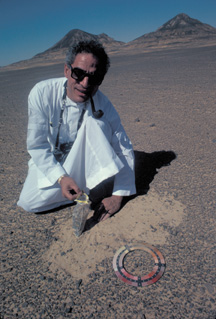 The desert is
the least understood of all land types. Many believe that it is a lifeless,
static wasteland. In reality, seeds of life are always hidden beneath the sands
and await a drop of rain. The desert surface is also fragile. Its protector
is a single layer of gravel and pebbles that armors underlying soil from the
aggressive wind. Removal of that layer causes the finest grains to be lifted
by the air as dust. Larger grains accumulate into sand dunes, which continue
to move as long as the wind blows.
The desert is
the least understood of all land types. Many believe that it is a lifeless,
static wasteland. In reality, seeds of life are always hidden beneath the sands
and await a drop of rain. The desert surface is also fragile. Its protector
is a single layer of gravel and pebbles that armors underlying soil from the
aggressive wind. Removal of that layer causes the finest grains to be lifted
by the air as dust. Larger grains accumulate into sand dunes, which continue
to move as long as the wind blows.During the recent war in Iraq, thousands of tanks and armored personnel carriers sped in multiple lanes from Kuwait toward Baghdad. The race through the desert disrupted the natural stabilizing layer of surface pebbles and exposed the underlying fine-grained soil to the wind. Televised images of the armored movement showed the results of this disruption: clouds of enveloping dust.
During the months that preceded the war, Iraqi military and Coalition forces alike spent much time digging trenches and pits or building berms and sand walls. It is the thing to do for military forces in an open desert — usually to hide troops and equipment. In some cases, these activities are meant to keep the troops busy and fit.
Farouk El-Baz samples the "desert pavement" in Egypt's Western Desert. The pavement is a gravel layer that protects the fine-grained soil beneath from wind erosion. Photo courtesy of Boston University Center for Remote Sensing.
Scarring the terrain with these hollows and heaps also destroys the protective layer of pebbles and exposes the soil below to wind erosion. Surface irregularities represent impediments in the path of the wind, which acts to return the land to its original flat posture — the path of least resistance. The outcome is that the dust remains airborne, increasing health and visibility hazards. The impediments also become the initiators of sand dunes that encroach on roads, runways, farms and the occasional abodes of Bedouin tribes.
There is a lesson for preservation in how the protective layer of pebbles formed in the first place. The land of Kuwait and southern Iraq used to be a flat river delta. That ancient river carried its sediments over 850 kilometers from the mountains along the Red Sea coast to the west. When the river dried up 5,000 years ago, the wind began to segregate its delta deposits.
The wind whirled particles with diameters smaller than 0.05 millimeter into the atmosphere as dust. Those from 0.05 to 0.5 millimeter were winnowed out to accumulate into sand dunes. Grains from 0.5 to 2 millimeters erratically rolled on the surface. Gravel pieces larger than 2 millimeters in diameter lagged behind to form a "desert pavement." This one-grain-thick layer serves as an armor that protects the underlying sediments from further wind erosion. It took a vast amount of soil erosion and sorting to form the protective layer in the first place. It would require the same process and similarly long amount of time to regenerate the layer.
My recognition of this process is based on long-term field observations in desert areas in North Africa and the Arabian Peninsula. A desert pavement of gravel and pebbles formed in a windy environment south of the Kharga Oasis in the Western Desert of Egypt over a period of 25 years. In the case of Kuwait, partial development of a gravel layer began over a four-year period at Jal Az-Zor escarpment. I shared my observations with the Kuwait Foundation for the Advancement of Sciences, which passed it on to the U.N. Compensation Commission.
At the end of that war 12 years ago, Kuwait's government asked me to conduct a study of the conflict's environmental effects. Using computers at the Boston University Center for Remote Sensing, I compared satellite images taken both before and after the military action. Changes detected based on these comparisons were checked in the field to confirm the satellite image interpretations. I determined that the desert pavement was disrupted in over 20 percent of the land area of Kuwait.
I conveyed my fear of a long-term environmental problem to then American Ambassador to Kuwait, Edward Gnehm, who introduced me to General P.X. Kelley, who commanded the U.S. Marines in Kuwait. General Kelley lamented that no one had brought this up earlier, before 90 percent of the Marines had gone home. He pointed out that they could have leveled the modified land prior to their departure to limit the damaging environmental consequences, which would have dramatically lessened the problem.
The present conflict has further disrupted the desert pavement in northern Kuwait and southern Iraq. Continued scarring of the desert surface, along with a lack of remedial action upon cessation of military activities, shows that the lessons from the Gulf War remain unheeded. As the Coalition forces slowly turn to peace-keeping efforts, their work to restore order within the cities should be extended to include restoring environmental order to the desert. Military personnel should be assigned to flatten the desert surface where it has been modified. They should perform this task while they still have the equipment there.
Restoring the land to the original flat contours would limit the long-term effects of wind erosion and allow faster regeneration of the desert pavement. This restoration is the only way to contain the damage to the environment and help the desert heal its war wounds.

